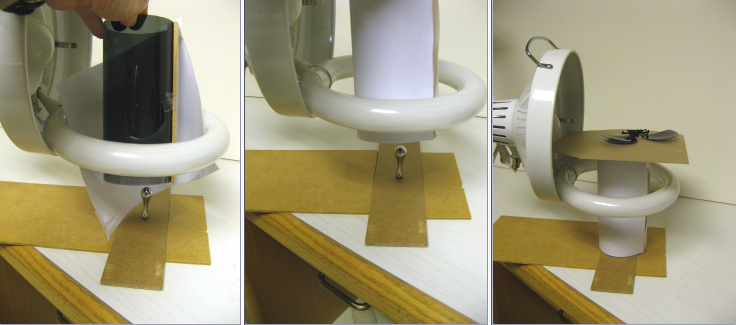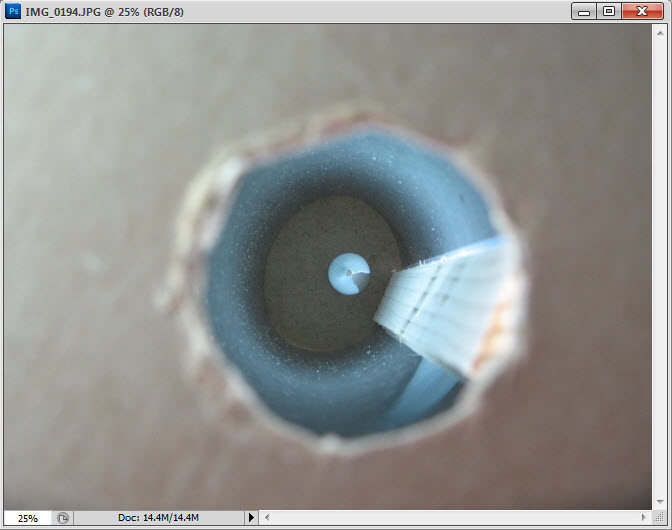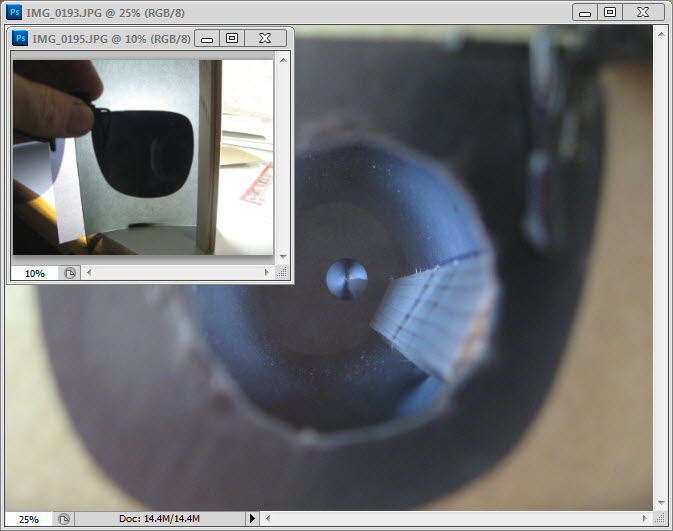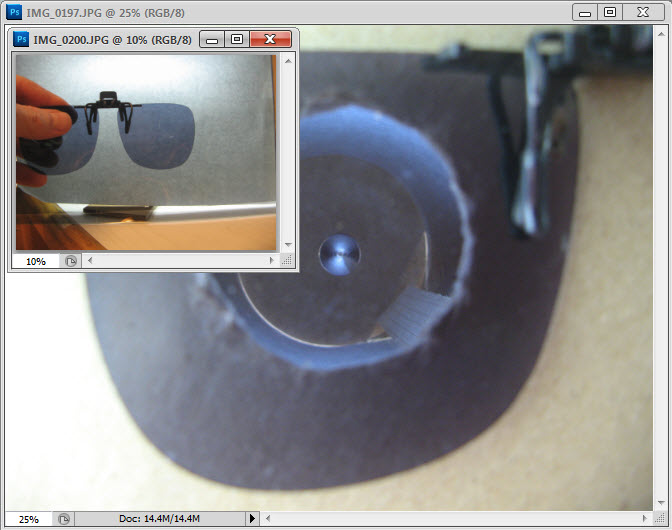Hey Rik, I read your post just after writing the first part of this (but before the “conclusions” section) and I believe you must be a mind reader!

Simplify subject---check!
Chrome sphere as subject---check!
Two-bladed rotating fan---check!
The good news is I was able to abbreviate the conclusions, as you’ve already covered most of that, too!
----------------------------------------
Well, it occurred to me that the essentially infinite number of permutations involved in testing combinations of diffusers and polarizers along with the strong dependence on the surface qualities (especially shape!) of a particular (complex) subject, makes it very difficult to precisely determine how the light source and subject are interacting, as seen by the camera. So I decided to try to simplify the experiment in an attempt to reduce some of the variables---hopefully these are not over simplifications, but simplifications in the Einsteinian sense of "Everything should be made as simple as possible, but not simpler."
Setup:
I am aware of two broad categories of specular surfaces, dielectric (e.g. plastics, glass and organic materials)---and bare metallic materials. A dielectric surface will reflect polarized light from an unpolarized source if the angle of incidence is at or near Brewster angle, while a purely metallic surface will simply maintain whatever polarization (or lack of polarization) is present in the source, regardless of the angle of reflection. So for simplified subjects in the following images, I chose spherical shapes made of uncoated metal (chrome ball and ball bearing) and a clear glass marble for the dielectric surface (I would have also included a metallic beetle in the frame for reference, but I don’t currently have one on hand). Smooth, spherical subjects were selected so they would reflect an impression of the light source intensity distribution being projected onto the subjects. They were stuck to the stage with a blob of modeling clay and were photographed free standing in a darkened room to prevent any stray reflections (with matte green background).
In each of the two test series below, a good quality circular polarizer (Nikon 52mm cir-pol) was used as an analyzer in front of the lens (Nikon Micro-nikkor 105mm f/2.8 AF-D on a Nikon D700).
Test Series 1 (small diameter, flat, diffused polarized source):
Because of the tendency of a broad light source, which is shaped into a sphere, arc or tube surrounding the subject to reflect or back-scatter light from the primary beam back to onto the subject from adjacent walls, I simplified the lighting arrangement in this test by using a small, flat, circular (40mm diameter) collimated light source (LED flashlight). The flashlight had diffusion film first, followed by a polarizing film taped over the front reflector. The plane of polarization was determined and marked on the film by reflecting the beam off of a dielectric (glass) surface at near Brewster’s angle. At minimum reflection, the polarization of the film should be orthogonal to the surface of the glass. This was also verified to be consistent with the “polarized sunglasses” method mentioned by AndrewC.
The polarized light source was used as a “probe” to determine the reflections off of the subjects at different incidence angles and planes of polarization of the source and rotations of analyzer polarizing filter. Each pair of images were taken with the light source coming from either the front left or right of the subject, at approximately 45 degrees from the x,y,z axes The plane of polarization for each L, R pair was maintained at the same angle relative to the optical axis of the lens as the source was moved from left to right. Exposure was kept the same for each set.
In these first two images, the source polarization angle was arranged parallel to the optical axis. In the first image, the analyzer was rotated to achieve maximum extinction and remained in that position for the second image.


In this pair, the analyzer was in the same rotation as the first pair, but the source was rotated to be orthogonal (perpendicular) to the optical axis.


Here the analyzer was rotated 90 degrees, with the source parallel.


Source moved further away from subject simulating more of a point source, max extinction point.

Test Series 2 (broad, flat, diffused polarized source)
The light source in this test was made from a rectangular (150mm x 210mm) strongly-diffusing plastic plate (stock part from a Nikon R1C1 flash kit) covered with polarizing film on the side facing the subject. The source was positioned directly over the subjects, as close as possible (just out of frame). The analyzer filter was rotated to the angle shown in the caption. (Edit: This better shows Rik’s “fan blade” effect.)
Centered (0 degrees)

30 degrees left

30 degrees right

180 degrees

Conclusions
The results are consistent with Rik’s observations in the current thread and in previous threads. In terms of using cross polarizers to cancel or reduce specular reflections, the key factors are the degree of polarization and polarization angle of the light as reflected
off of the subject relative to the plane of polarization of the polarizing filter (analyzer) on the lens. For a curved surface like the spheres used here, the plane of polarization rotates depending on the angle of the reflected beam, thus making it impossible to completely cancel the reflection from a diffuse polarized source, if it covers a wide angle relative to the (curved) subject. However, it is possible to largely cancel the specular reflection from a point polarized source. I didn’t show it here; but it is also possible to substantially reduce specular reflections from an arbitrary single flat surface, under the conditions tested here. Perhaps this may help to explain why Charles was able to almost completely eliminate the reflections on his mostly flat shield bug?:
http://www.photomacrography.net/forum/v ... hp?t=11254
But is if you look closely at this image, I think it’s possible to see the “fan blade” effect in some of the reflections from the beads of moisture on the insect.
Another effect that is apparent in these tests is that the fan blade does indeed rotate depending on whether the source polarization is parallel or orthogonal to the optical axis. I would guess that this is why Andrew’s images appear different in these two cases.
As is often the case in doing these tests, some (possibly new, probably not) ideas have “spontaneously generated” in my feeble mind. So once again, I’ll throw them at the preverbal wall to see if they stick. In Andrew’s early thread on this topic, Morfa (John) suggested making a box out of polarizing material in which the sides were rotated to compensate for the inherent rotation of the source or sources as reflected off of the subject from different directions. Based on the above tests, I think this idea has merit---at least for specific subjects.
What if we take this idea to the next logical step and cut strips or patches of polarizing film and assemble them into the desired shape (say bonded to the inside of a diffusion film) so that the plane of polarization is oriented to the correct angle to compensate for reflection angle off each part of the subject? Taken to the extreme (this may not be possible to manufacture), what if a polarizing film could be made (perhaps formed into a sphere), where the plane of polarization changes around the sphere so that the subject is illuminated by polarized light such that the reflections can be canceled with a polarizer on the camera?
One obvious issue with this concept---while I believe this might be useful for symmetrical surfaces like spheres, I can foresee that there might be problems with other arbitrary shapes or mixtures of shapes. So in the end, there may be no perfect solution.
Edit: While I've got the stage setup for these tests, I just took a quick look (using Live View) at one of my favorite subjects, a jumping spider (
P. johnsoni). Illuminated with the polarized flashlight held at close distance and rotating the polarizing filter on the lens I could make the reflections in the large eyes look like horizontal or vertical pupils. Ya know, cat eyes on a jumping spider just don't look right!






















